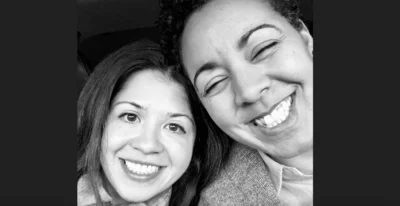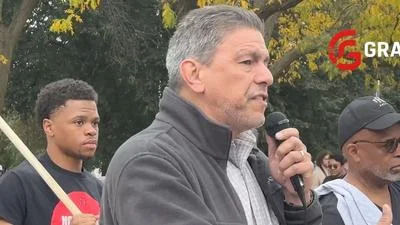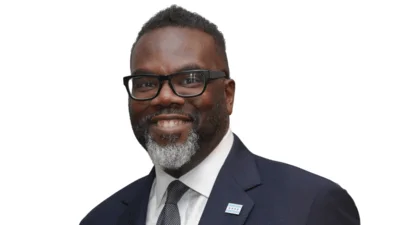The Illinois State Board of Education met Sept. 21 to review campus financial aid systems.
Here are the meeting's minutes, as provided by the board:
Illinois State Board of Education Illinois School Funding Reform Commission Meeting Minutes—1 7573_09/16 Illinois School Funding Reform Commission Meeting Minutes Meeting Summary as Approved by Commission Members Tuesday, September 21, 2016 12:00 p.m.–3:00 p.m. ? Illinois State Board of Education, Videoconference Room (3rd Floor), 100 N. First St., Springfield, Illinois ? Illinois State Board of Education, Videoconference Room (14th Floor), 100 W. Randolph, Suite 14-300, Chicago, Illinois Attendees Commission Members Chicago Jason Barickman, Senator, 53rd District Daniel Biss, Senator, 9th District Fred Crespo, Representative, 44th District Sheri Jesiel, Representative, 61st District Rita Mayfield, Representative, 60th District Emily McAsey, Representative, 85th District Dan McConchie Senator, 26th District Karen McConnaughay Senator, 33rd District Bob Pritchard, Representative, 70th District Sue Rezin, Senator, 38th District Christine Winger, Representative, 45th District Springfield Avery Bourne, Representative, 95th District Jennifer Hammer, Chief of Staff for Policy, Office of the Governor Dwight Kay, Representative, 112th District Andy Manar, Senator, 48th District Beth Purvis (Chairperson), Secretary of Education Evelyn Sanguinetti, Lieutenant Governor Jodi Scott, Regional Superintendent of Schools for Henderson, Knox, Mercer, and Warren Counties Illinois State Board of Education Illinois School Funding Reform Commission Meeting Minutes—2 Call-In Participants James Dimas, Secretary, Department of Human Services Kimberly Lightford, Senator, 4th District James T. Meeks, ISBE Chairman Illinois State Board of Education (ISBE) Staff Amanda Elliott, Legislative Affairs Jason Hall, Division Administrator, State Funding and Forecasting Sarah Hartwick, Legislative Affairs Leticia Pickens, Policy Analyst, State Funding and Forecasting Tony Smith, State Superintendent of Education Robert Wolfe, Chief Financial Officer Midwest Comprehensive Center (MWCC) Staff Jeremy Rasmussen Presenters Robert Wolfe, Illinois State Board of Education Jessica Handy, Stand for Children Mike Jacoby, Executive Director of the Illinois Association of School Business Officials Meeting Objectives ? Understand what is meant by hold harmless. ? Understand funding distribution models. Opening Chairman Meeks called the meeting to order at 12:00 p.m. Twenty-one members were in attendance, and a quorum was present. Chairman Meeks started the meeting by thanking the commission members for their great work so far. Dr. Purvis said the last meeting was a conceptual conversation on adequacy and equity and now the commission will be diving into things that look at issues critical to the understanding of crafting a new funding formula, which include different interpretations of hold harmless and how Illinois State Board of Education Illinois School Funding Reform Commission Meeting Minutes—3 the distribution of funds works. She said the next conversation they have will be focused on property taxes and how they affect funding. Motion to approve minutes: Representative Pritchard. Presentations Hold Harmless (Presentation by Robert Wolfe) Robert Wolfe began by providing a general definition of hold harmless and said that hold harmless provisions are meant to restrict declines in revenues, while others limit revenue increases. He said that under the current Illinois state aid formula, there are two examples of this: ? State aid is based on the greater of the three-year average daily attendance or the current year’s best three months average daily attendance. ? The three-year average Department of Human Services population for the calculation of the supplemental low-income grant Wolfe said that these examples are both built-in hold harmless provisions within the general state aid formula. He said that hold harmless provisions provide stability to districts while the new funding formula is implemented. He also said that hold harmless provisions can help perpetuate past distributions. Wolfe then gave a short history of the various hold harmless provisions in Illinois. In 1999–2010, there were four specific hold harmless provisions. The general state aid formula, which went into effect in 1999, stated that no district would receive any less state aid than it did in 1998 and had no sunset provision. Another hold harmless provision was the supplemental general state aid grant, which compared the base year with 2003 and had a 2007 sunset provision that was extended through the budget implementation bill. Wolfe then gave an example of a hold harmless provision that went through multiple iterations. The example he provided was the special education provision, which provided funding for children requiring special education services. It was effective in fiscal year (FY) 2005 and had a base year of 2004. It also had a 2007 sunset provision, but it was reinstated in 2008, with 2007 as the base year. The last hold harmless provision Wolfe discussed was a line item on the Illinois State Board of Education budget called transitional assistance. It was effective in 2004 and had a base year of 2003. It guaranteed that no district would receive less total funding from state distributions in the current year when compared with the prior year. It was eliminated in 2010. Wolfe said the takeaway of these four hold harmless provisions is that they all went on for a certain period and that there are districts that fall in and out of hold harmless because of demographic changes, economic development, or economic decline. He said that 2017 aid was comparable with 2016 gross general state aid at the $6,119 foundation level. He said that 713 of the 922 entities receiving general state aid in FY 2017 had a gross amount that was less than the gross amount for FY 2016 general state aid. He said assuming 2016 as a base amount, approximately $307.9 million would be needed to fund a hold harmless that guaranteed no district would have received less in 2017 than it received in 2016. He said assuming 2016 per- Illinois State Board of Education Illinois School Funding Reform Commission Meeting Minutes—4 pupil amount received as a base amount, approximately $263 million would be needed to fund a hold harmless that guaranteed no district would have received, on a per-pupil basis, less in 2017 than it received, on a per-pupil basis, in 2016. Wolfe said it’s important to understand the factors that contribute to general state aide loss. He listed a number of things that could lead to loss of general state aid from one year to the next, including: ? Increase in the equalized assessed valuation (EAV) used in the calculation of general state aid; ? Increase in personal property replacement tax receipts; ? Decrease in average daily attendance; ? Low-income changes; ? Decrease in Department of Human Services Population; and ? Decrease in the concentration level of Department of Human Services Population. Some other factors Wolfe mentioned include: ? Decrease in gross income; ? Increase in property tax; ? Increase in Average Daily Attendance; and ? Increase in low income. Senator Barickman asked if these numbers account for the supplemental poverty grant that legislators allocated in FY 2017. Wolfe said no, these numbers do not account for that. Senator Barickman said that districts would have received additional dollars on top of their general state aid claim that would skew the number who received less from one year to the other. Wolfe said that is correct. Representative Mayfield said Wolfe had mentioned that only the special education funding was still not being funded. She said it hasn’t been funded for a few years, which is why there has been so much pushback from the districts concerning the charters because we are not funding it. If we are taking about hold harmless, we need to talk about that line item as well. Wolfe said he does not have the history on that, but he could try to retrieve it. Dr. Purvis said this question could be followed up on in the next meeting. Senator Rezin said she had a question regarding the two different definitions of hold harmless. Illinois State Board of Education Illinois School Funding Reform Commission Meeting Minutes—5 She asked if Wolfe if he could explain the pros or cons of either of them. Wolfe said if you are talking about general districts, hold harmless prevents districts that receive less funding as a result of change from going below standard. One of the things we talk about is who are we holding harmless. With hold harmless, there are two sides to the equation and because we still have the same players sitting at the table, there is a direct effect on both parties. He said another participant in the state at this table is the state and the cost of available revenue at the time. In terms of pros and cons, it is really about perspective. Representative Pritchard asked, when we talk hold harmless, are we talking about districts or hold harmless per student? Wolfe said that in this context, we are talking about districts. Representative Pritchard then asked if there is any research that says what the hold harmless period should be. Wolfe said he didn’t know if there is any research. He said that is a policy decision and there are variations. Dr. Purvis said the other thing about hold harmless is that we have different funding streams, and we need to determine if the hold harmless is affecting the spending at the district level because it may or may not. So the question becomes, what is the local ability to make up for some of these? Representative Crespo asked, when you look at the hold harmless and you establish a baseline, do you adjust for inflation? Wolfe said there was no adjustment for inflation. Wolfe said if a new funding formula is considered with no additional revenue, then there are going to be winners and losers. Some other factors Wolfe said could result in the loss of general state aid were: ? Decrease in gross income; ? Increase in EAV; ? Increase in property tax; ? Decrease in ADA (average daily attendance); and ? Decrease in low income. Wolfe said if you look at the average daily attendance [referring to data on slide], this is a district serving K–12 that lost 10 students. These 10 students were probably dispersed throughout the grade span. He said it would be impossible for 10 fewer students—in this case—to result in a reduced class size because there would be no opportunity for the district to save on costs. You have to have a large student decline that would result in the elimination of a few classrooms, Illinois State Board of Education Illinois School Funding Reform Commission Meeting Minutes—6 which would reduce your costs. If you hold districts harmless per pupil amount, then that would account for the loss of students. You will not be paying for hold harmless for students who no longer exist. What you will be paying for is changes in payments to the districts because they have more revenue. Wolfe said that is exactly right, as the demographics and the district becomes more wealthy, the cost to the state becomes less. A committee member from Springfield asked if the list on what lead to loss in general state aid is exhaustive. She said she thought she heard earlier that fewer kids living in poverty was not part of what led to general losses in state aid. Wolfe said these are the factors that contribute to the losses in general state aid only, but there could be additional things going forward as the formula is implemented that could create additional losses. Wolfe then went on to some additional factors to consider in a singular education funding formula that could create the need for hold harmless: ? If a greater amount of state funding is equalized or ? If districts have a disproportionate amount of reliance on a particular categorical reimbursement. Dr. Purvis added that transportation is something that has a disproportionate effect depending on the district. Wolfe then went some additional factors that could result in a district being held harmless: ? Loss of students; ? Changes in low-income counts; ? A hold harmless provision for districts that have high tax burden; ? A period of time for which hold harmless provisions are in place; and ? Districts having no loss in local receipts. Wolfe then reviewed the impact of hold harmless provisions, listed as: ? Provides districts with a level of predictability and stability; ? A phased-in hold harmless provision will allow time for planning for districts that would receive more or less in a revised state education funding system; ? An understanding that hold harmless provisions are a diversion of the amount of available funding from the intended goals of a revised state funding system for education funding; and ? Hold harmless provisions should be reviewed to ensure that horizontal equity and vertical equity do not become inequitable. Illinois State Board of Education Illinois School Funding Reform Commission Meeting Minutes—7 A committee member [Springfield] said that Wolfe mentioned categorical reimbursements and joint agreement and cooperatives being left out and was wondering if that would be an argument against sharing services and consolidation. Wolfe said no, he did not believe so and gave an example for his reasoning. Representative McAsey asked if there have been other states that have recently looked at changing their funding formulas, and what have they have done concerning implementation of hold harmless. Dr. Purvis brought up an analysis that looked at states and hold harmless. She said it will be sent out as part of the readings. Representative McAsey brought up an earlier point from Wolfe on how hold harmless delays the implementation of the formula change. She asked, does that assume that there is no additional funding coming in? Wolfe said you could say that, but even with additional money it can still take longer to achieve your goal. Representative McAsey asked, is there a benefit to not having a sunset to ensure that your funding never falls below a certain minimum level? Wolfe said it would depend upon how you define what that minimum level is. Understanding Funding Distributions Models (Presentation by Jessica Handy and Mike Jacoby) Jessica Handy said defining adequacy and equity are important conceptual guiding principles, but unless we have $3 to $5 billion more to invest in education next year, it won’t happen immediately. She said this committee will need to make choices on what factors to take into consideration when deciding how to give out funds. So, it’s important to ask, how do we distribute the limited resources we have and any new revenue that becomes available? And what types of hold harmless are reasonable to transition to the new formula? Illinois State Board of Education Illinois School Funding Reform Commission Meeting Minutes—8 Handy then gave some background on how the current school funding system works, which includes: • TRS is not based on student need or local ability to pay (TRS, including normal costs and unfunded liability, is about 35% of PK–12 budget). • Categoricals include about 20 different programs that are mostly based on student need, but not local ability to pay (categoricals are about 20% of the PK–12 budget). • GSA foundation level formula is based on local ability to pay but not student need (GSA is 30% of the PK–12 budget). • Low income GSA is based on student need, but not local ability to pay (low income is 15% of the PK–12 budget). Handy said general state aid is driven by a foundation level. She said there is no magic or logic to the foundation level. As your percentage of local resources increases, the amount of state aid received decreases. She said a big question is, how do you calculate local resources? Handy then talked about the PTELL adjustment. She said that (1) tax caps prevent districts from levying more than they did last year plus inflation and (2) the formula is used to apply the assumed tax rate to all EAV, regardless of how much a district couldn’t access. She said the PTELL adjustment helps adjust for both of these items. Handy then talked more about low-income concentration grants. She said that they are part of the GSA formula but calculated independently of foundation level. She said the grant provides between $355 and $3,000 per pupil, depending on low-income concentration. Handy then talked about categoricals. She said mandated categoricals include five special education lines, which are transportation, orphanage tuition, and free breakfast and lunch. Other categoricals include bilingual education, early childhood, agricultural education, career and technical education, Advanced Placement class subsidies, and consolidation incentive payments. She said that each one of these has a different distribution method and that CPS gets most of its categorical funding through flexible block grants based on 1995 distribution percentages. Representative Crespo asked how much were the Chicago block grants? Handy said she believes it is about $586 million, approximately $250 million more than if they had to submit claims. Representative Crespo asked, what is special education defined as? Handy said that special personnel reimbursement is driven by certified special ed teachers. The special ed funding for children is based on 85% enrollment in the school and 15% on poverty. Handy then touched upon the teachers’ retirement system. She said that there is a 3.5 billion state payment for teacher pensions for all districts except CPS and that $800 million is the normal cost and that $3 billion is unfunded liability. Illinois State Board of Education Illinois School Funding Reform Commission Meeting Minutes—9 A committee member [Springfield] asked if there are any examples of states that incorporate teacher pension cost into their funding model. Handy said that a lot of states have districts paying for pensions locally and that’s how it would be incorporated. Another committee member [Springfield] asked if those same states are the ones that don’t have a state teacher retirement system and if the local boards are determining what those pensions are. Handy said no. Representative McAsey asked, how did you arrive at the number $3 to $5 billion for the additional investment? Handy said EFAB has said you need about $5 billion more to reach the optimal foundation level for the current system. Senator Barickman said it is important to think about how we determine what is available locally. He said that factors in greatly to what the additional investment number would be. Handy then talked about Senate Bill (SB) 231 (Better Funding for Better Schools) and what the funding model would like under it: ? TRS would not be based on student need or local ability to pay. ? Catergoricals would mostly be based on student need but not local ability to pay. ? Primary state aid (PSA) would be based on student need and local ability to pay. ? Hold harmless would not be based on student needs or local ability to pay. Handy added that SB 231, instead of having multiple complex, competing formulas distributing money to schools, would centralize most of it into one formula: primary state aid. She said every district would be assigned a weighted foundation level that reflects its poverty rate and concentration, which would be based on applying weights to a foundation level that would increase or decrease based on the appropriation. She said the PSA provides equalization grants to districts reflecting how many resources they have locally and what they need to educate their specific population of students. Handy said that SB 231 drives new money toward the highest poverty districts and that the final version includes three versions of hold harmless. A committee member asked, how are regional cost differences determined? Senator Manar said there is a wage index that you build up from. Mike Jacoby said that the evidence-based model (EBM) has two parts: a way to define adequacy and a way to distribute dollars. He said that, like SB 231, EBM is an integrated formula. Every district has a unique adequacy target calculated, and most state education funds are integrated Illinois State Board of Education Illinois School Funding Reform Commission Meeting Minutes—10 into one formula. He said the distribution side is separate from the adequacy calculation. Based on the equalized assessed valuation in the district, the model estimates the local capacity a district has to contribute to its schools. He said that every district is guaranteed its base funding minimum, which is a per-pupil hold harmless. Jacoby asked, how do we take the gap between what every district needs in order to fund adequacy and what they already have? He said some of those gaps are going to be large. To address this, EBM has four tiers: ? Tier 1—Districts are funded at less than 60% of their adequacy target. These districts will get 33% of all new money. ? Tier 2—Districts are funded at less than 90% of their adequacy target, including Tier 1 districts. These districts will get 66% of all new money. ? Tier 3—Districts are funded between 90% and 100% of adequacy. They will get 0.9% of new money. ? Tier 4—Districts are funded above adequacy. They will get 0.1% of new money. Senator Manar said one of the challenges with the winners and losers discussion is that we also want to be able to balance not having only the poorest districts being advocates for the money. Jacoby said, for those who are in Tier 3 and Tier 4, the one thing they say repeatedly is just don’t take anything away from us. Representative Crespo asked, conceivably, we could go back to this hold harmless five or four years from now? Jacoby said yes and that you would probably want to. You don’t want to put something in place and never look at it again. Senator McConnaughay said there are two different EAV systems in Illinois; how do you deal with that? Jacoby said we didn’t do anything with assessment side of EAV. Handy then went over what a combination of SB 231 and EBM might look like. She said implementing 231 before implementing EBM would have the effect of significantly raising the floor for the highest poverty districts before moving to the EBM. She said in the first year of EBM, districts would be held harmless to the higher funding level they received under the 231 model through their based funding minimum. Representative Mayfield said her concern is that there is no new money. Handy referred to a graph to illustrate what would happen if there was no new money. Senator Barickman said in the three years we have been having this conversation, we all recognize the financial climate that we live in, but there has been decision after decision that has Illinois State Board of Education Illinois School Funding Reform Commission Meeting Minutes—11 increased the amount of state dollars into education funding. With every moment we don’t come to an agreement on this, those opportunities are lost. If everyone agrees that the formula is broken but we put more money into it, then we are all consciously upholding a flawed system. Handy said that EBM would raise the amount every low-income student gets regardless of the concentration of low-income students in a district. Handy said this year’s education budget took a step forward toward a more equitable system while also pausing many of the inputs at FY 2016 levels: ? Every district received the same GSA allocation as FY 2016. ? An equity grant was added that distributed $250 million in proportion to the FY 2016 poverty grant allocation. ? Any district that would have received more if the FY 2017 model were fully funded would receive the additional amount needed to reach its FY 2017 GSA allocation. Handy then talked about HB 813, which is a modified equity grant. She said this concept was raised as an oversimplified mechanism to direct new funds in the most equitable way. Although the poverty grant is equitable, it still has no measure of local wealth. The modified equity grant would have corrected that and incorporated local wealth and poverty rate. Handy concluded with a list of considerations: ? How will you calculate local wealth and treat tax caps? ? Will you move to an integrated formula? ? Should every district receive a minimum amount of state support? ? How should a hold harmless be structured? ? Should funding be based on enrollment, average daily attendance, or an average of several years of data? ? Will you provide additional funds for poverty concentration? ? Should new funds be narrowly targeted to raise the floor for the neediest districts, or should it be allocated more broadly? The meeting adjourned at 3:00 p.m.






 Alerts Sign-up
Alerts Sign-up